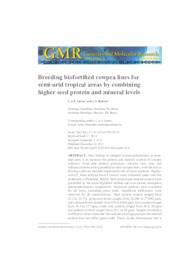Breeding biofortified cowpea lines for semi-arid tropical areas by combining higher seed protein and mineral levels.
Breeding biofortified cowpea lines for semi-arid tropical areas by combining higher seed protein and mineral levels.
Autoria: SANTOS, C. A. F.; BOITEUX, L. S.
Resumo: One strategy to mitigate human malnutrition in semi-arid areas is to increase the protein and mineral content of cowpea cultivars. Total seed protein, potassium, calcium, iron, zinc, and sodium contents were quantified in elite cowpea lines, with the aim to develop cultivars that had improved levels of these nutrients. Eighty-seven F6 lines derived from 6 crosses were evaluated under rain-fed conditions in Petrolina, Brazil. Seed protein and mineral content were quantified by the micro-Kjeldhal method and in an atomic absorption spectrophotometer, respectively. Statistical analyses were estimated for all traits, including grain yield. Significant differences were observed for all characteristics. Seed protein content ranged from 22.5 to 34.1%, potassium levels ranged from 20,200 to 27,000 ppm, and calcium levels ranged from 410 to 6260 ppm. Iron content ranged from 36.5 to 137 ppm, while zinc content ranged from 36 to 58 ppm and sodium content ranged from 29.2 to 88 ppm. Simple correlation coefficient values indicated that selection for high protein and mineral content does not affect grain yield. These results demonstrate that it higher levels of protein and essential minerals.
Ano de publicação: 2013
Tipo de publicação: Artigo de periódico
Unidade: Embrapa Semiárido
Palavras-chave: Bean, Cultivares, Feijão, Feijão-caupi, Linhas de feijão-caupi biofortificados, Nutrição humana, Proteína, Semente, Semiárido
Observações
1 - Por padrão são exibidas publicações dos últimos 20 anos. Para encontrar publicações mais antigas, configure o filtro ano de publicação, colocando o ano a partir do qual você deseja encontrar publicações. O filtro está na coluna da esquerda na busca acima.
2 - Para ler algumas publicações da Embrapa (apenas as que estão em formato ePub), é necessário ter, no celular ou computador, um desses softwares gratuitos. Sistemas Android: Google Play Livros; IOS: iBooks; Windows e Linux: software Calibre.
Acesse outras publicações
Acesse a Base de Dados da Pesquisa Agropecuária (BDPA) para consultar o acervo completo das bibliotecas da Embrapa.

